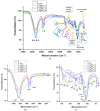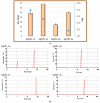Biocomposite Materials Derived from Andropogon halepensis: Eco-Design and Biophysical Evaluation
- PMID: 38473696
- PMCID: PMC10934486
- DOI: 10.3390/ma17051225
Biocomposite Materials Derived from Andropogon halepensis: Eco-Design and Biophysical Evaluation
Abstract
This research work presents a "green" strategy of weed valorization for developing silver nanoparticles (AgNPs) with promising interesting applications. Two types of AgNPs were phyto-synthesized using an aqueous leaf extract of the weed Andropogon halepensis L. Phyto-manufacturing of AgNPs was achieved by two bio-reactions, in which the volume ratio of (phyto-extract)/(silver salt solution) was varied. The size and physical stability of Andropogon-AgNPs were evaluated by means of DLS and zeta potential measurements, respectively. The phyto-developed nanoparticles presented good free radicals-scavenging properties (investigated via a chemiluminescence technique) and also urease inhibitory activity (evaluated using the conductometric method). Andropogon-AgNPs could be promising candidates for various bio-applications, such as acting as an antioxidant coating for the development of multifunctional materials. Thus, the Andropogon-derived samples were used to treat spider silk from the spider Pholcus phalangioides, and then, the obtained "green" materials were characterized by spectral (UV-Vis absorption, FTIR ATR, and EDX) and morphological (SEM) analyses. These results could be exploited to design novel bioactive materials with applications in the biomedical field.
Keywords: Andropogon halepensis; Pholcus phalangioides; antioxidant activity; biocomposites; silver nanoparticles; spider silk; “green” synthesis.
Conflict of interest statement
The authors declare no conflicts of interest.
Figures









References
-
- Mohanta Y.K., Mishra A.K., Panda J., Chakrabartty I., Sarma B., Panda S.K., Chopra H., Zengin G., Moloney M.G., Sharifi-Rad M. Promising applications of phyto-fabricated silver nanoparticles: Recent trends in biomedicine. Biochem. Biophys. Res. Commun. 2023;688:149126. doi: 10.1016/j.bbrc.2023.149126. - DOI - PubMed
-
- Zgura I., Badea N., Enculescu M., Maraloiu V.A., Ungureanu C., Barbinta-Patrascu M.-E. Burdock-Derived Composites Based on Biogenic Gold, Silver Chloride and Zinc Oxide Particles as Green Multifunctional Platforms for Biomedical Applications and Environmental Protection. Materials. 2023;16:1153. doi: 10.3390/ma16031153. - DOI - PMC - PubMed
-
- Barbinta-Patrascu M.-E., Bacalum M., Antohe V.A., Iftimie S., Antohe S. Bio-nanoplatinum phyto-developed from grape berries and nettle leaves: Potential adjuvants in osteosarcoma treatment. Rom. Rep. Phys. 2022;74:601.
Grants and funding
LinkOut - more resources
Full Text Sources
Miscellaneous

